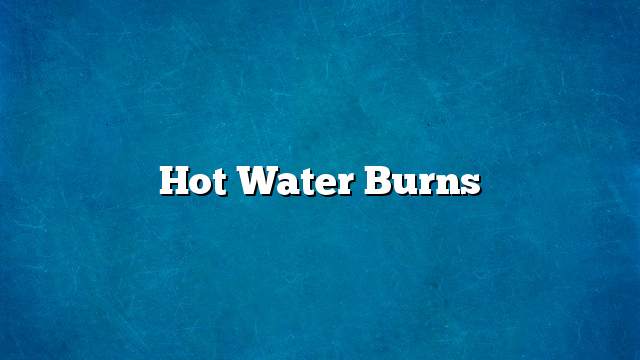Hot water burns
The causes and forms of burns vary in adults and children, including burns caused by the exposure of the skin to direct fire, including electric and chemical burns, burns caused by touching hot objects, etc. But all burns are similar to the most difficult injuries a person can experience in his life, And the longest in terms of healing period. Hot burns may vary from water to spilled water, from water, shower water, or any hot liquid such as tea or coffee cups, and may also be caused by hot water vapor called scald burn. Children aged six and under, and children with disabilities, are most likely to be burned; most of the burns are caused by hot water. It is worth mentioning that children are more likely to have deeper burns and even lower temperatures than others, because of the relatively thin skin of their skin compared to those who are older.
Types of hot water burns
The symptoms associated with hot water burns vary depending on the degree of burning. Hot water can cause any of the following three degrees of burn:
The degree of incineration unit varies depending on the temperature of the hot liquid and the duration of exposure. The following table shows the time required for the occurrence of serious toxic burns in children, depending on the temperature of the water, all of them in Celsius unit:
| Liquid type | temperature | Time |
|---|---|---|
| Boiling water | ° 100 | Less than a second |
| Hot cup of tea or coffee | ° 95- ° 70 | Less than a second |
| Hot water from the tap | ° 60 | a second |
| Hot water resulting from leaving boiling water to cool for 5-10 minutes | ° 55 | 10 seconds |
| Hot water from tap with heat regulator | 50 ° | 5 minutes |
Treatment of hot water burns
First aid for hot water burns
There is a set of measures to be followed when hot water burns occur, as follows:
- Remove non-stick clothing quickly to avoid heat retention, and to expose the entire burned area.
- Remove jewelry and anything that is attached to the body or tightly attached to it, because skin tissue is usually swollen after burns.
- Cool the burns with a cool water stream for at least 20 minutes to avoid injury to the lower layers of the skin.
- Cover the area with burns with a clean cloth.
- It is recommended to lift the arm or leg if affected by burns, in order to avoid swelling and swelling of these areas.
Things to avoid in case of burns
The following are some things to avoid when dealing with burns to avoid complications of burning:
- The position of the child with burns is prohibited in a cold water bath.
- It prevents the opening of water bubbles caused by burns.
- It is advisable to avoid home remedies such as butter and eggs for lack of effectiveness.
- The use of cotton on burns is prohibited to avoid adhesion of small fibers in the area and thus increase the chance of infection.
- Use of oil and ointments on burns is prohibited to avoid internal heat retention.
- Ice is not used to prevent chills in children.
Cases that require medical intervention
Some cases of hot water burns may require medical care.
- Deep burning regardless of pain.
- Large-scale burning; larger than 20 centimeters.
- Incineration which involves injury to the face, hands, feet, joints, or genitals.
- Incineration shows signs of infection; there is an increase in redness of the skin, swelling of the skin, or exhalation of pus from burning.
- Burns that produce white or charcoal skin regardless of the size of the burn.
- Burns in young children under five, and pregnant women.
Prevention of hot water burns
There are many tips that can be followed to avoid the occurrence of hot water burns especially in children, including:
- Make sure that there is a barrier to prevent the child from entering the kitchen, especially when preparing food.
- Be sure to place utensils, pots and hot drinks cups away from the edges of tables and tables.
- Do not leave the hot water bucket on the ground, where the child can easily reach it.
- Do not eat hot drinks by parents if the child is near them.
- It is recommended to check the temperature of the bath water by hand before putting the baby in it.
- Do not leave the child without parental control in the bathroom.
- Adjust the water temperature regulator at home to between 38 and 48 degrees Celsius.
- Cool-mist humidifier is recommended to help prevent burns caused by hot water vapor or hot water.
